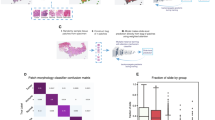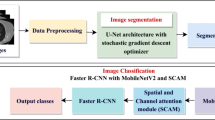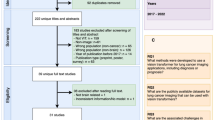Abstract
Background
Lung adenocarcinoma is a common cause of cancer-related deaths worldwide, and accurate EGFR genotyping is crucial for optimal treatment outcomes. Conventional methods for identifying the EGFR genotype have several limitations. Therefore, we proposed a deep learning model using non-invasive CT images to predict EGFR mutation status with robustness and generalizability.
Methods
A total of 525 patients were enrolled at the local hospital to serve as the internal data set for model training and validation. In addition, a cohort of 30 patients from the publicly available Cancer Imaging Archive Data Set was selected for external testing. All patients underwent plain chest CT, and their EGFR mutation status labels were categorized as either mutant or wild type. The CT images were analyzed using a self-attention-based ViT-B/16 model to predict the EGFR mutation status, and the model’s performance was evaluated. To produce an attention map indicating the suspicious locations of EGFR mutations, Grad-CAM was utilized.
Results
The ViT deep learning model achieved impressive results, with an accuracy of 0.848, an AUC of 0.868, a sensitivity of 0.924, and a specificity of 0.718 on the validation cohort. Furthermore, in the external test cohort, the model achieved comparable performances, with an accuracy of 0.833, an AUC of 0.885, a sensitivity of 0.900, and a specificity of 0.800.
Conclusions
The ViT model demonstrates a high level of accuracy in predicting the EGFR mutation status of lung adenocarcinoma patients. Moreover, with the aid of attention maps, the model can assist clinicians in making informed clinical decisions.




Similar content being viewed by others
Data availability
The data from The First Affiliated Hospital of Wenzhou Medical University that support the findings of this study are not publicly available due to intellectual property considerations. However, the data used for external validation in this study are available in The Cancer Imaging Archive (TCIA), as detailed in references [14, 15].
Abbreviations
- EGFR:
-
Epidermal growth factor receptor
- CT:
-
Computed tomography
- ViT:
-
Vision transformer
- AUC:
-
Area-under-the-ROC-curve analysis
- Grad-CAM:
-
Gradient-weighted class activation mapping
References
Bray F, Ferlay J, Soerjomataram I, Siegel RL, Torre LA, Jemal A. Global cancer statistics 2018: GLOBOCAN estimates of incidence and mortality worldwide for 36 cancers in 185 countries. CA Cancer J Clin. 2018;68:394–424.
Xu J-Y, Zhang C, Wang X, Zhai L, Ma Y, Mao Y, et al. Integrative proteomic characterization of human lung adenocarcinoma. Cell. 2020;182:245-261.e17.
Molinier O, Goupil F, Debieuvre D, Auliac J-B, Jeandeau S, Lacroix S, et al. Five-year survival and prognostic factors according to histology in 6101 non-small-cell lung cancer patients. Respir Med Res. 2020;77:46–54.
Sharma SV, Bell DW, Settleman J, Haber DA. Epidermal growth factor receptor mutations in lung cancer. Nat Rev Cancer. 2007;7:169–81.
Li T, Kung H-J, Mack PC, Gandara DR. Genotyping and genomic profiling of non–small-cell lung cancer: implications for current and future therapies. J Clin Oncol. 2013;31:1039–49.
Bai H, Wang Z, Chen K, Zhao J, Lee JJ, Wang S, et al. Influence of chemotherapy on EGFR mutation status among patients with non–small-cell lung cancer. J Clin Oncol. 2012;30:3077–83.
Zhao W, Yang J, Ni B, Bi D, Sun Y, Xu M, et al. Toward automatic prediction of EGFR mutation status in pulmonary adenocarcinoma with 3D deep learning. Cancer Med. 2019;8:3532–43.
Shamai G, Binenbaum Y, Slossberg R, Duek I, Gil Z, Kimmel R. Artificial intelligence algorithms to assess hormonal status from tissue microarrays in patients with breast cancer. JAMA Netw Open. 2019;2: e197700.
Gao R, Zhao S, Aishanjiang K, Cai H, Wei T, Zhang Y, et al. Deep learning for differential diagnosis of malignant hepatic tumors based on multi-phase contrast-enhanced CT and clinical data. J Hematol OncolJ Hematol Oncol. 2021;14:154.
Peng S, Liu Y, Lv W, Liu L, Zhou Q, Yang H, et al. Deep learning-based artificial intelligence model to assist thyroid nodule diagnosis and management: a multicentre diagnostic study. Lancet Digit Health. 2021;3:e250–9.
Vaswani A, Shazeer N, Parmar N, Uszkoreit J, Jones L, Gomez AN, et al. Attention is All you Need. Adv Neural Inf Process Syst [Internet]. Curran Associates, Inc.; 2017 [cited 2022 Oct 1]. Available from: https://papers.nips.cc/paper/2017/hash/3f5ee243547dee91fbd053c1c4a845aa-Abstract.html. Accessed 1 Oct 2022.
Dosovitskiy A, Beyer L, Kolesnikov A, Weissenborn D, Zhai X, Unterthiner T, et al. An Image is Worth 16x16 Words: Transformers for Image Recognition at Scale [Internet]. arXiv; 2021 [cited 2022 May 26]. Available from: http://arxiv.org/abs/2010.11929. Accessed 26 May 2022.
Dearden S, Stevens J, Wu Y-L, Blowers D. Mutation incidence and coincidence in non small-cell lung cancer: meta-analyses by ethnicity and histology (mutMap). Ann Oncol. 2013;24:2371–6.
Clark K, Vendt B, Smith K, Freymann J, Kirby J, Koppel P, et al. The cancer imaging archive (TCIA): maintaining and operating a public information repository. J Digit Imaging. 2013;26:1045–57.
Gevaert O, Xu J, Hoang CD, Leung AN, Xu Y, Quon A, Rubin DL, Napel S, Plevritis SK. Non-small cell lung cancer: identifying prognostic imaging biomarkers by leveraging public gene expression microarray data–methods and preliminary results. Radiology. 2012;264:387–96.
Selvaraju RR, Cogswell M, Das A, Vedantam R, Parikh D, Batra D. Grad-CAM: visual explanations from deep networks via gradient-based localization. Int J Comput Vis. 2020;128:336–59.
Riely GJ, Pao W, Pham D, Li AR, Rizvi N, Venkatraman ES, et al. Clinical course of patients with non-small cell lung cancer and epidermal growth factor receptor exon 19 and exon 21 mutations treated with gefitinib or erlotinib. Clin Cancer Res. 2006;12:839–44.
Zhang H, Cai W, Wang Y, Liao M, Tian S. CT and clinical characteristics that predict risk of EGFR mutation in non-small cell lung cancer: a systematic review and meta-analysis. Int J Clin Oncol. 2019;24:649–59.
Lambin P, Leijenaar RTH, Deist TM, Peerlings J, de Jong EEC, van Timmeren J, et al. Radiomics: the bridge between medical imaging and personalized medicine. Nat Rev Clin Oncol. 2017;14:749–62.
Jia T-Y, Xiong J-F, Li X-Y, Yu W, Xu Z-Y, Cai X-W, et al. Identifying EGFR mutations in lung adenocarcinoma by noninvasive imaging using radiomics features and random forest modeling. Eur Radiol. 2019;29:4742–50.
Lu X, Li M, Zhang H, Hua S, Meng F, Yang H, et al. A novel radiomic nomogram for predicting epidermal growth factor receptor mutation in peripheral lung adenocarcinoma. Phys Med Biol. 2020;65: 055012.
Cheng B, Deng H, Zhao Y, Xiong J, Liang P, Li C, et al. Predicting EGFR mutation status in lung adenocarcinoma presenting as ground-glass opacity: utilizing radiomics model in clinical translation. Eur Radiol. 2022;32:5869–79.
Wang S, Shi J, Ye Z, Dong D, Yu D, Zhou M, et al. Predicting EGFR mutation status in lung adenocarcinoma on computed tomography image using deep learning. Eur Respir J. 2019;53:1800986.
Huang X, Sun Y, Tan M, Ma W, Gao P, Qi L, et al. Three-dimensional convolutional neural network-based prediction of epidermal growth factor receptor expression status in patients with non-small cell lung cancer. Front Oncol. 2022;12: 772770.
Jiang Y, Ma S, Xiao W, Wang J, Ding Y, Zheng Y, et al. Predicting EGFR gene mutation status in lung adenocarcinoma based on multifeature fusion. Biomed Signal Process Control. 2023;84: 104786.
Pao JJ, Biggs M, Duncan D, Lin DI, Davis R, Huang RSP, et al. Predicting EGFR mutational status from pathology images using a real-world dataset. Sci Rep. 2023;13:4404.
Fidler-Benaoudia MM, Torre LA, Bray F, Ferlay J, Jemal A. Lung cancer incidence in young women vs. young men: a systematic analysis in 40 countries. Int J Cancer. 2020;147:811–9.
Acknowledgements
This research did not receive any specific grant from funding agencies in the public, commercial, or not-for-profit sectors.
Funding
The authors declare that no funds, grants, or other support were received during the preparation of this manuscript.
Author information
Authors and Affiliations
Contributions
All authors contributed to the study conception and design. Material preparation, data collection and analysis were performed by LW, YX and HS. The first draft of the manuscript was written by LW and all authors commented on previous versions of the manuscript. All authors read and approved the final manuscript.
Corresponding author
Ethics declarations
Conflict of interest
The authors have no relevant financial or non-financial interests to disclose.
Ethical approval
This retrospective study had received approval from the ethics committee of our institution (Approval No. KY2022-R174).
Informed consent
As all data used in the study had been anonymized, we were not required to obtain informed consent from the patients.
Additional information
Publisher's Note
Springer Nature remains neutral with regard to jurisdictional claims in published maps and institutional affiliations.
Rights and permissions
Springer Nature or its licensor (e.g. a society or other partner) holds exclusive rights to this article under a publishing agreement with the author(s) or other rightsholder(s); author self-archiving of the accepted manuscript version of this article is solely governed by the terms of such publishing agreement and applicable law.
About this article
Cite this article
Weng, L., Xu, Y., Chen, Y. et al. Using Vision Transformer for high robustness and generalization in predicting EGFR mutation status in lung adenocarcinoma. Clin Transl Oncol (2024). https://doi.org/10.1007/s12094-023-03366-4
Received:
Accepted:
Published:
DOI: https://doi.org/10.1007/s12094-023-03366-4




